Octopus and squid are two of the most fascinating and distinctive creatures in the marine world. Both belonging to the class Cephalopoda, share several common features, including a soft body, a mantle, and tentacles. Despite these similarities, octopuses and squids differ remarkably in many aspects, ranging from physical characteristics to behavior and habitat.
What are Octopuses?
Octopuses are marine creatures known for their eight flexible arms and remarkable intelligence. Belonging to the class Cephalopoda, these soft-bodied animals are famous for their ability to change color and texture for camouflage.
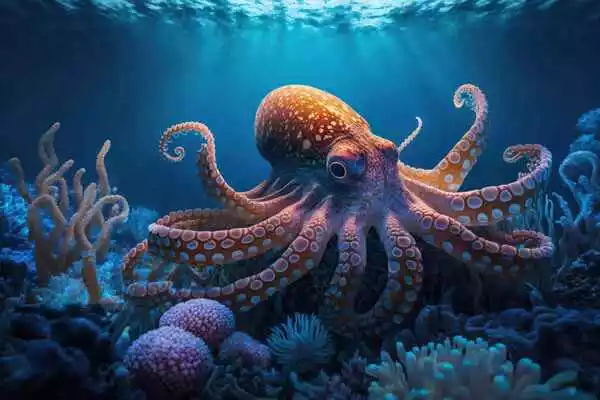
They inhabit various ocean environments, from coral reefs to deep-sea floors. Octopuses are solitary and often characterized by their clever escape techniques, problem-solving skills, and use of tools, making them one of the most interesting inhabitants of the ocean.
What are Squids?
Squids are fast-swimming, elongated cephalopods known for their streamlined bodies and ten tentacles. Two of these tentacles are longer and used for capturing prey. They are widely recognized for their ability to jet-propel through water, eject ink as a defense mechanism, and display remarkable color changes.
Squids are found in a variety of marine habitats, ranging from shallow coastal waters to deep ocean. They play a crucial role in the marine food chain, both as predators and prey, and are also significant in human culture and cuisine around the world.
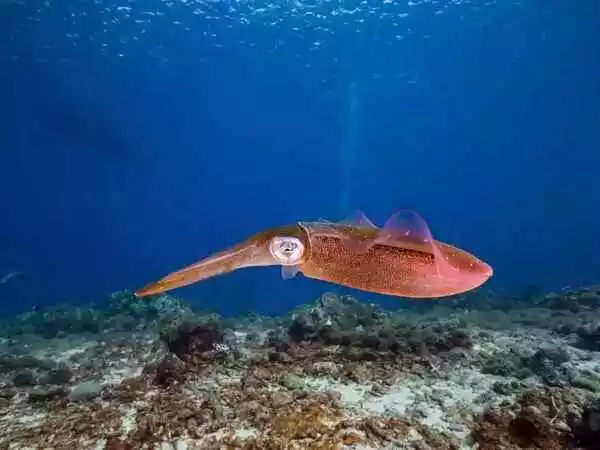
Comparison chart: Octopus vs Squid
Here’s a comparison chart of the key differences between octopuses and squids:
| Feature | Octopus | Squid |
|---|---|---|
| Classification | Order Octopoda | Order Teuthida |
| Body Shape | Rounded, sack-like | Elongated, torpedo-shaped |
| Skeleton | No internal or external skeleton | Small internal structure (pen or gladius) |
| Arms/Tentacles | 8 arms with suction cups | 8 arms + 2 longer tentacles with suction cups |
| Size Range | Varies; from a few inches to over 16 feet (Giant Pacific Octopus) | Varies; from small to over 40 feet (Giant Squid) |
| Locomotion | Crawls using arms; swims by expelling water from the mantle | Fast, jet-propelled swimming by expelling water from the mantle |
| Camouflage | Excellent; can change color and texture | Good; can change color, less versatile in texture change |
| Habitat | Various marine environments, mostly near the sea floor | Various marine environments, including open-water |
| Intelligence | Highly intelligent; known for problem-solving and tool use | Less studied; shows signs of intelligence |
| Diet | Carnivorous; feeds on small fish, crabs, etc. | Carnivorous; feeds on fish, other squids, etc. |
| Defense Mechanisms | Camouflage, ink, mimicry | Ink, speed, sometimes camouflage |
| Reproduction | Lays eggs in hidden locations; often dies after breeding | Lays eggs in open water; life cycle varies by species |
Octopuses have a unique and fascinating physical structure:
- Body: Their main body, called the mantle, is soft and sack-like, housing most of their vital organs. This flexibility allows them to squeeze through tiny spaces.
- Arms: They possess eight arms, each lined with suction cups. These arms are highly flexible and strong, used for movement, capturing prey, and sensing their environment.
- Size: Varies greatly among species, from a few inches to over 16 feet in span for larger species like the Giant Pacific Octopus.
- Skin: Known for their ability to change both color and texture for camouflage and communication, thanks to specialized cells called chromatophores.
- Head: The head houses the brain and eyes. Octopus eyes are well-developed and similar to those of vertebrates, offering excellent vision.
- Beak: At the center of the arms is a hard, parrot-like beak, used to break into shells of prey.
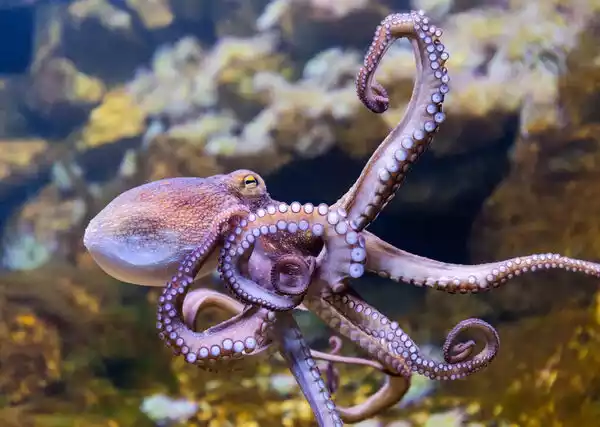
This structure, combined with their intelligence and ability to adapt, makes octopuses highly efficient hunters and survivors in diverse marine habitats.
Physical structure of Squids
Squids have a distinct physical structure adapted for their fast-paced, open-water lifestyle:
- Body: Squids have a streamlined, elongated body, with a mantle that encloses their internal organs. This shape is ideal for fast swimming.
- Arms and Tentacles: They have eight shorter arms and two longer tentacles, which are specialized for capturing prey. The tentacles can extend rapidly to snatch prey and then retract.
- Size: Size varies among species, ranging from small to very large, like the Giant Squid, which can reach lengths over 40 feet.
- Fins: Most squids have fins on either side of their mantle, which they use for steering and stability in water.
- Skin: Like octopuses, squids can change color using cells called chromatophores, but their ability for texture change is less advanced.
- Siphon: A siphon is used for breathing and propulsion, enabling squids to move rapidly through water by jet propulsion.
- Beak: Squids have a hard, sharp beak at the mouth, used for cutting prey into manageable pieces.
This structure enables squids to be agile and effective hunters in the marine environment, playing a significant role in the oceanic food chain.
Habitat and Distribution – Octopus vs Squid
Octopuses and squids inhabit a wide range of marine environments across the world’s oceans. Octopuses are commonly found in diverse habitats, from shallow, coastal waters to the deeper parts of the ocean. They often prefer rocky areas, coral reefs, and seabed crevices where they can hide and hunt.
Squids, on the other hand, are more widespread in open waters, including both the surface and deeper sea levels. Some species of squid live in the deep ocean, while others are found in more coastal areas.
Both creatures are known for their adaptability, which allows them to thrive in various environmental conditions and geographical locations, from the tropics to temperate zones, making them globally distributed across different marine ecosystems.
Behavioral Traits – Octopus vs Squid
Octopuses and squids exhibit intriguing behavioral traits that adapt them to their marine environments. Octopuses are known for their remarkable problem-solving abilities, often using tools and displaying complex cognitive skills.
They are primarily solitary creatures and employ a range of defense mechanisms like camouflage and ink expulsion to avoid predators. In contrast, squids are fast swimmers, using jet propulsion to move swiftly through open waters.
They display a strong predator-prey relationship, actively hunting and feeding on fish and other squids. While both cephalopods possess a level of intelligence, octopuses tend to exhibit more intricate behaviors due to their solitary and inquisitive nature, whereas squids focus on agility and speed for survival in their environment.
Lifespan of Octopus and Squid
Octopuses
-
- Most octopuses are relatively short-lived, typically ranging from 1 to 2 years.
- Larger species, like the Giant Pacific Octopus, may have a slightly longer lifespan, usually around 3 to 5 years.
- Octopuses are known for having a relatively brief life cycle, with individuals typically mating, laying eggs, and then dying shortly after hatching.
Squids
-
- Squid lifespans vary among species.
- Some smaller squid species have very short lifespans, often less than a year.
- Larger squid species, such as the Giant Squid, can live longer, possibly up to 3 to 5 years.
- Like octopuses, squids also reproduce once during their lifetime and die shortly after spawning.
Reproduction of Octopus and Squid
Octopus Reproduction
- Octopuses are typically semelparous, which means they reproduce only once in their lifetime.
- Male octopuses use a specialized arm called a hectocotylus to transfer spermatophores (sperm packets) into the female’s mantle cavity.
- The female octopus lays a large number of eggs in a hidden location, such as a crevice or den, to protect them from predators.
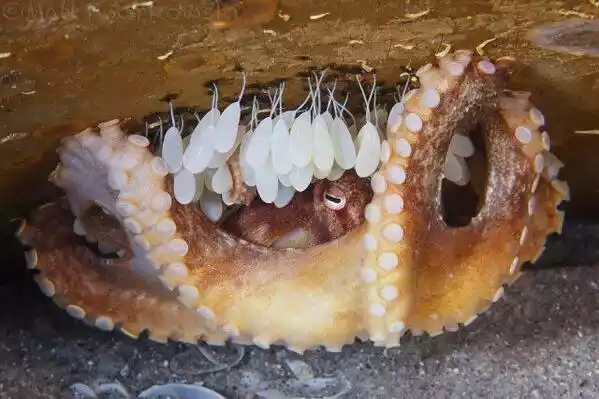
- The female guards and cares for the eggs, continuously aerating them and cleaning away debris. During this time, she does not eat and eventually dies shortly after the eggs hatch.
- After hatching, octopus offspring enter a planktonic larval stage, drifting in the open ocean before settling on the sea floor and developing into adult octopuses.
Squid Reproduction
- Most squid species are also semelparous, reproducing only once in their lifetime.
- Squids have specialized mating rituals, and males transfer sperm to the female using a modified arm.
- Female squids release a gelatinous egg mass into open water or attach it to substrates.
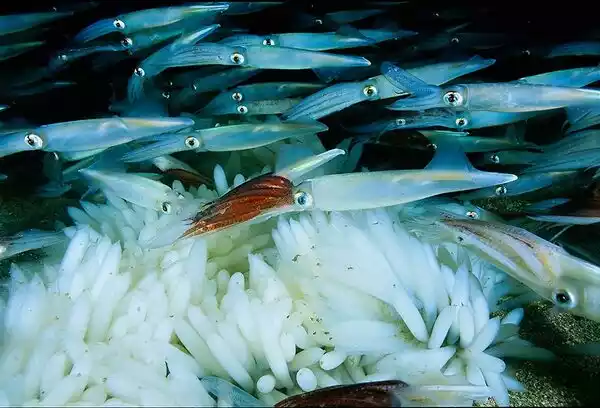
- Unlike octopuses, squid females do not provide parental care to their eggs. They often die after laying eggs.
- Squid hatchlings, known as paralarvae, closely resemble miniature adults and do not go through a planktonic larval stage. They must fend for themselves from the moment they hatch.
Diet and Feeding Habits
Octopuses and Squids, both being carnivores, possess distinct feeding habits and diets determined according to their strategies for hunting and the environment they live in. Octopuses are predators that can be opportunistic, eating a variety of prey species, including small fishes as well as crabs, shrimps, and Mollusks.
They are renowned for their smartness and impressive abilities to think through problems while capturing prey. Octopuses are known to employ ambush or stealth techniques employing their strong arms as well as suction cups, to bind and imprison their prey.
Their beak, which is located in the middle of the arms is utilized to crush shells, allowing access to the fleshy part of their victims.
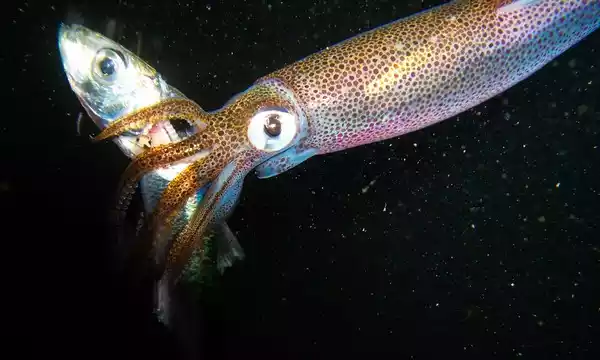
Squids on the other side, are swift swimmers, using their speed to capture prey, such as fish and other species of squids. They use two specially designed tentacles, which are equipped with sharp hooks, to capture and imprison their prey.
Squids are renowned for their ferocious appetites and are a vital element of the food chain of marine animals. Their sharp beaks, similar to the parrot’s can allow them to break pieces of their prey into small pieces for eating.
Economic Importance of Octopus and Squid
Octopuses and squids hold economic significance in various ways. They are commercially valuable marine species, often caught for their meat, which is a popular seafood choice in many cuisines worldwide.
The fishing industry relies on these cephalopods for their economic contributions, providing employment and income to coastal communities. Additionally, octopus and squid fisheries are essential for global seafood trade, meeting consumer demand for delicious and nutritious seafood products.
Sustainable harvesting practices are crucial to ensure the long-term economic and ecological health of these valuable marine resources.
Why do octopuses have 3 hearts?
Octopuses have three hearts to efficiently circulate blood throughout their bodies and adapt to their environment. Two of these hearts, called branchial hearts, are responsible for pumping oxygen-poor blood through the gills, where it becomes oxygenated.
The third heart, known as the systemic heart, then pumps the oxygenated blood to the rest of the octopus’s body, ensuring a constant supply of oxygen to its active muscles and organs. This unique circulatory system helps octopuses thrive in the oxygen-rich marine environments where they live, allowing for rapid swimming and agile movement.
Do squids have 2 hearts?
Yes, squids also have two hearts. Similar to octopuses, squids possess two main heart structures. One of these hearts pumps oxygen-poor blood to the gills, where it is oxygenated, while the other heart pumps the oxygenated blood to the rest of the squid’s body.
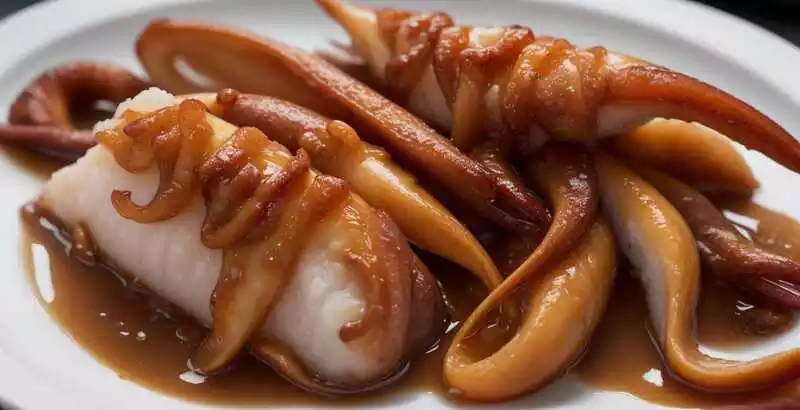
This dual-hearted circulatory system allows squids to efficiently distribute oxygen to their muscles and organs, supporting their rapid swimming and active lifestyle in the open waters of the ocean.
Conclusion
Octopuses and squids, while sharing some common traits as cephalopods, are distinct and fascinating creatures with unique physical structures, behaviors, and ecological roles. Their differences in lifespan, reproduction, diet, and economic importance highlight the diversity of life in the marine world and emphasize the importance of conservation efforts to protect these remarkable animals and their ecosystems.
